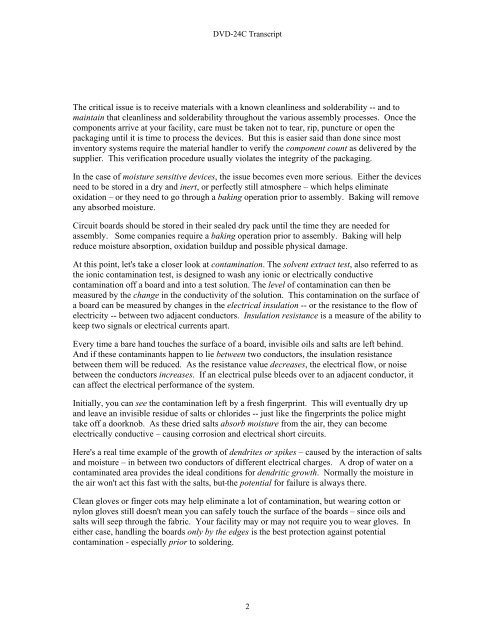DVD-24C Handling in Electronics Assembly - IPC Training Home ...
DVD-24C Handling in Electronics Assembly - IPC Training Home ...
DVD-24C Handling in Electronics Assembly - IPC Training Home ...
You also want an ePaper? Increase the reach of your titles
YUMPU automatically turns print PDFs into web optimized ePapers that Google loves.
<strong>DVD</strong>-<strong>24C</strong> Transcript<br />
The critical issue is to receive materials with a known cleanl<strong>in</strong>ess and solderability -- and to<br />
ma<strong>in</strong>ta<strong>in</strong> that cleanl<strong>in</strong>ess and solderability throughout the various assembly processes. Once the<br />
components arrive at your facility, care must be taken not to tear, rip, puncture or open the<br />
packag<strong>in</strong>g until it is time to process the devices. But this is easier said than done s<strong>in</strong>ce most<br />
<strong>in</strong>ventory systems require the material handler to verify the component count as delivered by the<br />
supplier. This verification procedure usually violates the <strong>in</strong>tegrity of the packag<strong>in</strong>g.<br />
In the case of moisture sensitive devices, the issue becomes even more serious. Either the devices<br />
need to be stored <strong>in</strong> a dry and <strong>in</strong>ert, or perfectly still atmosphere – which helps elim<strong>in</strong>ate<br />
oxidation – or they need to go through a bak<strong>in</strong>g operation prior to assembly. Bak<strong>in</strong>g will remove<br />
any absorbed moisture.<br />
Circuit boards should be stored <strong>in</strong> their sealed dry pack until the time they are needed for<br />
assembly. Some companies require a bak<strong>in</strong>g operation prior to assembly. Bak<strong>in</strong>g will help<br />
reduce moisture absorption, oxidation buildup and possible physical damage.<br />
At this po<strong>in</strong>t, let's take a closer look at contam<strong>in</strong>ation. The solvent extract test, also referred to as<br />
the ionic contam<strong>in</strong>ation test, is designed to wash any ionic or electrically conductive<br />
contam<strong>in</strong>ation off a board and <strong>in</strong>to a test solution. The level of contam<strong>in</strong>ation can then be<br />
measured by the change <strong>in</strong> the conductivity of the solution. This contam<strong>in</strong>ation on the surface of<br />
a board can be measured by changes <strong>in</strong> the electrical <strong>in</strong>sulation -- or the resistance to the flow of<br />
electricity -- between two adjacent conductors. Insulation resistance is a measure of the ability to<br />
keep two signals or electrical currents apart.<br />
Every time a bare hand touches the surface of a board, <strong>in</strong>visible oils and salts are left beh<strong>in</strong>d.<br />
And if these contam<strong>in</strong>ants happen to lie between two conductors, the <strong>in</strong>sulation resistance<br />
between them will be reduced. As the resistance value decreases, the electrical flow, or noise<br />
between the conductors <strong>in</strong>creases. If an electrical pulse bleeds over to an adjacent conductor, it<br />
can affect the electrical performance of the system.<br />
Initially, you can see the contam<strong>in</strong>ation left by a fresh f<strong>in</strong>gerpr<strong>in</strong>t. This will eventually dry up<br />
and leave an <strong>in</strong>visible residue of salts or chlorides -- just like the f<strong>in</strong>gerpr<strong>in</strong>ts the police might<br />
take off a doorknob. As these dried salts absorb moisture from the air, they can become<br />
electrically conductive – caus<strong>in</strong>g corrosion and electrical short circuits.<br />
Here's a real time example of the growth of dendrites or spikes – caused by the <strong>in</strong>teraction of salts<br />
and moisture – <strong>in</strong> between two conductors of different electrical charges. A drop of water on a<br />
contam<strong>in</strong>ated area provides the ideal conditions for dendritic growth. Normally the moisture <strong>in</strong><br />
the air won't act this fast with the salts, but the potential for failure is always there.<br />
Clean gloves or f<strong>in</strong>ger cots may help elim<strong>in</strong>ate a lot of contam<strong>in</strong>ation, but wear<strong>in</strong>g cotton or<br />
nylon gloves still doesn't mean you can safely touch the surface of the boards – s<strong>in</strong>ce oils and<br />
salts will seep through the fabric. Your facility may or may not require you to wear gloves. In<br />
either case, handl<strong>in</strong>g the boards only by the edges is the best protection aga<strong>in</strong>st potential<br />
contam<strong>in</strong>ation - especially prior to solder<strong>in</strong>g.<br />
2

















